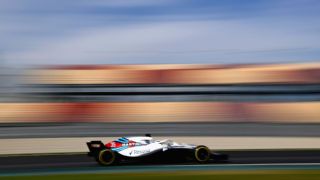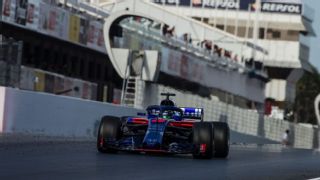After a gearbox issue in the morning of the final day, Carlos Sainz finally hit the track on low fuel and hyper-soft tyres in the afternoon and set a 1:18.092 -- making Renault the fourth fastest team of the test. But given McLaren's 0.3s advantage on the same tyre and Haas being 0.3s slower on a compound two steps harder, Renault is going to have to make every upgrade count to score serious points in the opening races. On the plus side, the R.S.18's solid reliability means it is likely to be in a position to capitalise if its closest rivals see a repeat of the showstoppers they experienced in testing.
Meanwhile, back at the team's factory in Enstone a great deal of investment is starting to come online and that is likely to result in some serious development over the course of the year. Renault is very much a team to watch in 2018.
Haas arrived in Barcelona having been set a lofty target by owner Gene Haas -- to close the gap to engine and technical partners Ferrari this year to 0.5s -- and left with a quietly optimistic mood. Though it finished at the lower end of the mileage table, the Haas VF-18 looked surprisingly quick. Kevin Magnussen posted an eye-catching super-soft lap on day seven, a 1:18.360, which when tyre-corrected using Pirelli's estimated delta times to the softest compounds, it brings the team close to the track record time set by Sebastian Vettel on the hyper-softs.
Though such comparisons are difficult to make with accuracy in testing, those laps were enough for Renault and McLaren to sit up and take notice, with both stating the American team could be a dark horse in the early stages of the season. Whether Haas can turn pre-season promise into regular season success is another matter. Haas boss Guenther Steiner put the impressive low-fuel runs down to getting the tyres to work properly, something which was its Achilles Heel in 2017. One caveat should be the limited mileage.
Consistently last year, the team would fail to locate or solve a problem early in a weekend, and it would snowball from there. Haas had several lengthy delays during the second week of testing. If the team is anywhere near as quick as some of its testing times suggested, its race operation is going to be under the spotlight more than ever to deliver.
Williams

After a solid if unspectacular season in 2017, Williams rocked up to pre-season testing with a revised 2018 aero concept. Given that it's the first car to be designed under the aero directorship of former Ferrari man Dirk de Beer, it's no surprise that the area ahead of the sidepods has more than a hint of SF70-H about it. But understanding that change in aero philosophy will not be the work of a moment and from the outside the team appeared to be struggling in testing.
On track the FW41 looked unbalanced and both Sergey Sirotkin and Lance Stroll struggled to hook up consistent laps. Last year Stroll had a hard time understanding the tyres, and between him and rookie Sirotkin it appears the team will have a significant challenge getting the most from Pirelli's notoriously tricky tyres this season. Robert Kubica should be able to help but it's worth remembering his knowledge of Pirelli rubber is also limited after seven years out of F1.
The team admitted to taking the wrong direction with setup midway through the second week but there was a sign of hope of the final day as Sergey Sirotkin set the FW41's fastest time of the week on soft tyres. Although the 1:19.189 kept Williams last in the overall lap time rankings, tyre-corrected to a time on hyper-softs using Pirelli's estimates he would have been in the mid 1:17s. The true pace of the Williams remains something of a mystery, but don't be surprised if the cars from Grove are a bit further up the order when it comes to qualifying in Australia.
Force India

On the face of it, Force India is in a bit of trouble coming into the new season. It looked much slower than the team which has comfortably finished best of the rest behind the front three for the previous two seasons. In fact, its deficit to the front in testing was 3.34 percent -- only Sauber's was higher. Its underwhelming winter was capped off by finishing eighth in the mileage table.
Esteban Ocon caused headlines early in the second week when he suggested the team's long-run pace was on a par with Red Bull, a team which has clearly closed the gap to the front since the Abu Dhabi Grand Prix last November. Whether the smiley Frenchman was genuinely optimistic or putting a brave face on things will become clear with time, but everything we saw from testing suggested the opposite is true.
Hanging over everything are the ongoing discussions about the team's rebrand, while it is clearly hoping to bring a radically different package to the opening race in Melbourne. That new upgrade will have to provide a big step forward if Force India wants to start the season anywhere close to where it finished 2017.
On an optimistic note, Force India has carved itself a reputation as one of the grid's most consistent performers in recent seasons, meaning there is reason to believe the team can find a good baseline with its race-spec challenger.
Toro Rosso

Toro Rosso's winter was a pleasant surprise. Given its past with McLaren, few were expecting new engine partner Honda to have such a problem-free pre-season and it only encountered a major issue on the final day. It's a deal which has clearly revitalised the Faenza-based squad after a challenging season last year as a Renault customer, which ended in acrimonious circumstances. Speaking in the second week, technical chief James Key sounded optimistic about the team's potential to move up the order this season.
Clearly, the partnership between team and engine manufacturer has started well and both parties are enjoying the new environment after last year. But it would be wrong to assume a good winter will automatically result in a strong start to the season. Both sides of this new team are starting from further back than they would like, meaning it is likely to be a while before significant gains are made in aerodynamic and engine performance. Headline times put Toro Rosso slap-bang in the middle of the order for testing.
It's fair to assume it will stay there, possibly starting in the lower reaches of the order, but crucially Toro Rosso may have finally found itself a strong foundation to launch a return to competitiveness. Honda's development through the season, and whether it is able to deliver Toro Rosso an engine with good driveability and reliability, will ultimately determine how it fares across the 21-race season.
Sauber

The new C37 is among the most distinctive cars on the 2018 grid but during testing it also looked like one of the most difficult to drive. Like Williams, Sauber has adopted a completely new aero concept this year in an attempt to propel itself up the standings. The gap to midfield may have slimmed, with Charles Leclerc's best time just 0.2s adrift of Force India and Toro Rosso using the same tyre compound, but don't expect the C37 to suddenly start featuring in Q2 on a regular basis.
Perhaps most concerning of all was the amount of mistakes Leclerc and Marcus Ericsson made on track. The car was a regular visitor to the gravel traps at Turn 4 and Turn 12 and appeared to have a loose rear end that both drivers struggled to keep under control on corner entry. The strong pace of the other two Ferrari-powered teams will give Sauber hope that it can move up the grid, but the rest of the field won't hang around waiting for its engineers to get their heads around the C37.
